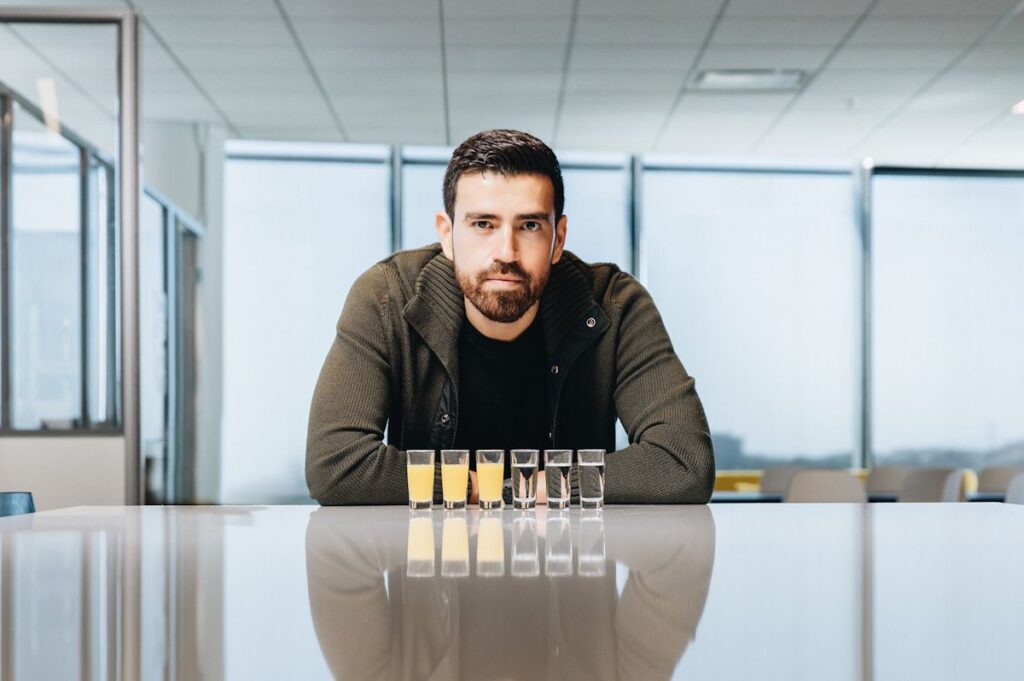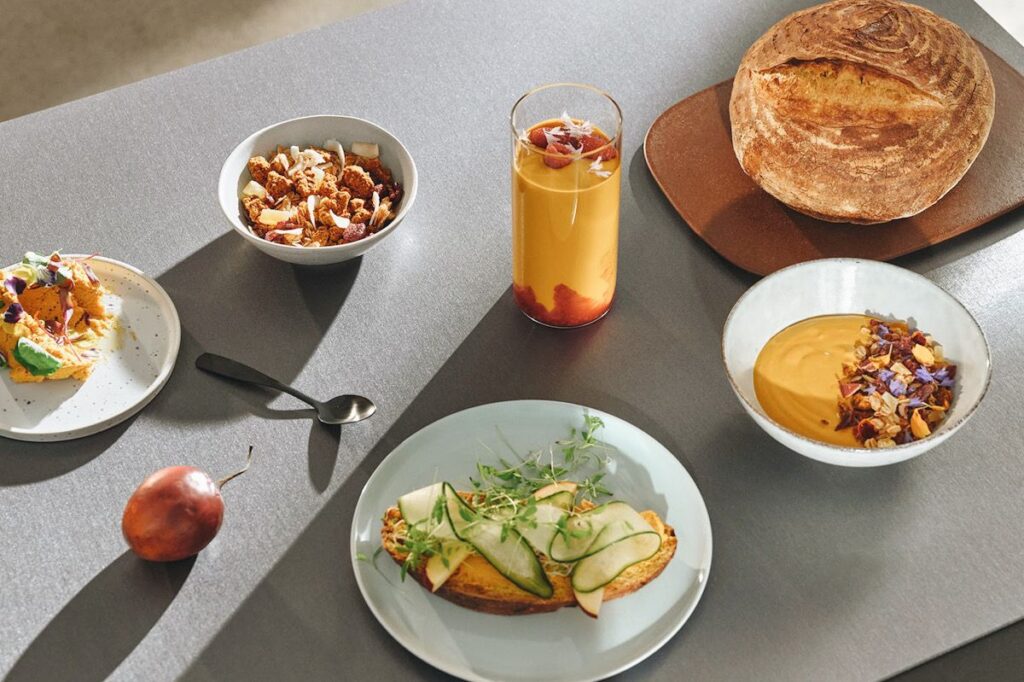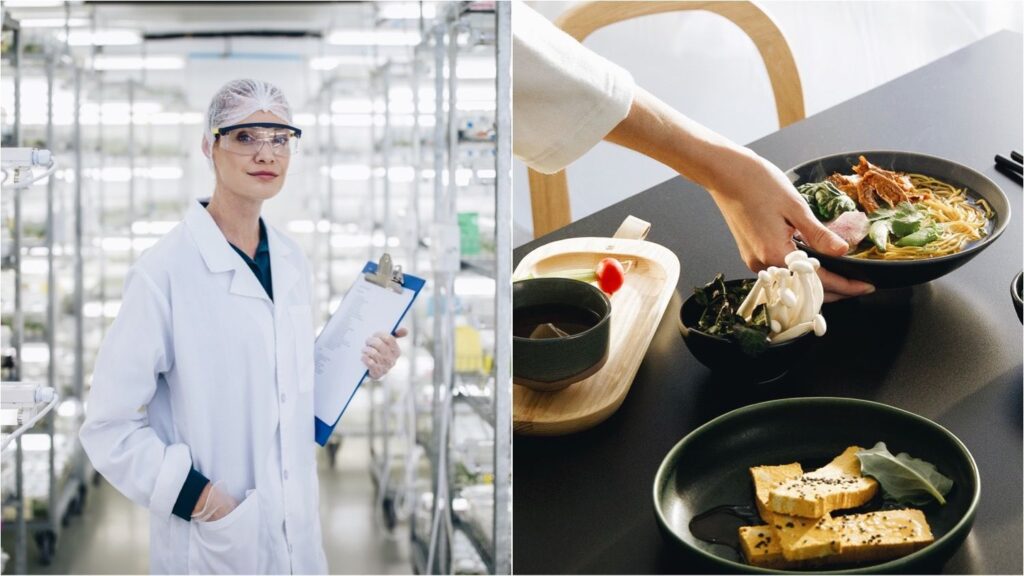We’ve almost made it through another rough year, folx. Not to reinforce toxic positivity or anything like that, but there was a lot of news worth celebrating, too. And, while reflecting on 2020, we realized that it’s been a pretty stellar 365 days for food tech. We were spot-on with some of last year’s predictions: vegan chicken is big, plant-based eggs and seafood took the spotlight, fermented protein is becoming the Next Big Thing, and 3D-printed steak is in luxury restaurants.
All of these are exciting developments, and it gets us speculating: What’s next in the future of food? Well, we’ll tell you what we think. Dairy-free milk that tastes just like cow’s milk. Meatless chicken made using the air we breathe. And part of the solution to food waste, which involves making snacks from scraps. If it’s not the kids who save us, it might just be the robots (hi, 3D-printing). The future of food tech has the power to shape not only our palates but influence how the world eats. Here are some highlights of what’s to come in 2022.

Animal-free dairy gets realistic
When it comes to the future of food, the more disruptive, the better. Of course, we’re talking about precision fermentation here, a critical food process that we’ve been excited about for some time now. And that torch is still burning. To briefly explain how it works, precision fermentation is a technology where microorganisms are “programmed,” kind of like little computers, to produce specific ingredients that can be used to make plant-based or cultivated products that taste and function like the animal-based version. Think: butter that browns and cheese that pulls, but the dairy proteins are produced in a fermentation tank instead of by a cow.
One of the most high-profile producers of these proteins is Berkeley, Calif.-based startup Perfect Day, which creates vegan whey and casein proteins using this technology. Its proteins were first available in ice cream back in 2020 and this year, it’s been used in cream cheese, cake mix, and animal-free whey protein powder.
The startup is just one example of the potential of precision fermentation. There are several companies leveraging microbes as little dairy protein-producing factories to make cheese, without the cows. And now milk is joining the mix. Late 2021 saw the launch of Mylkcubator, an incubation program created by a Spanish dairy giant, just for dairy-free milk startups. Out of the four companies in its inaugural class, three of them use precision fermentation.

Bacteria is out to make everything better
Precision fermentation isn’t just for dairy. It can generate animal-free egg proteins, ingredients like Impossible Foods’ heme protein (which adds color and an iron-rich flavor), and even protein for pet food.
But, precision fermentation is just one of three types of fermentation that are being used to improve alternatives to animal products. There’s traditional fermentation, where live organisms such as bacteria or yeast convert a carbohydrate like a starch or a sugar into an alcohol and acid. Most of us are very familiar with traditionally fermented foods, like sauerkraut, kimchi, miso, yogurt, beer, and aged cheeses are made. Many brands have proven that you can make plant-based yogurt and aged cheeses roughly the same way as the dairy versions.
There’s also biomass fermentation, which leverages fast-growing microorganisms to produce large amounts of protein that can be used in products. For decades, Quorn has been the most notable name in biomass fermentation with its fungi-based mycoprotein. But it’s no longer alone. More startups are using biomass fermentation to create analogs, from mycelium bacon and whole-cut steak to protein produced from CO2. Speaking of which …

Protein will come from strange places
Take “strange” with a grain of salt, because it’s the future of food. In 2021, expect to see food coming from unexpected sources, including geothermal hot springs, and the air we breathe.
With regard to the latter, there are currently two major players in the space: Air Protein in Berkeley and Solar Foods in Helsinki, Finland. The companies’ methods have their differences, but both produce edible material out of carbon dioxide (CO2). Both use biomass fermentation, leveraging microbes that eat CO2 and other elements of the air, and produce a physical protein that looks similar to flour. That flour can then be used to produce plant-based meats like burgers and meatballs. Sounds futuristic, right? But the fascinating thing, besides the fact that edible-for-humans protein is being created from air, is that Air Protein’s methods are based on methods laid out in a 1967 NASA study on how to grow food on board during long space missions.
While neither company has put a product on the market yet, we can likely expect to see updates in 2022. Air Protein secured $32 million in a Series A funding round earlier this year, part of which will be put towards its R&D lab, which will accelerate its product development and the commercialization of its technology. Solar Foods, which has been backed by the Finnish government, aims to have its first industrial facility to produce Solein, its proprietary protein, fully operational by 2023.
The air we breathe isn’t the only unusual source of protein. Chicago-based Nature’d Fynd grows Fy, a fermented fungi (hello again to our good friend biomass fermentation) produced using a microbe originating from the geothermal springs of Yellowstone National Park. It pre-released breakfast patties and cream cheese last February and announced the construction of a 200,000-square-foot facility this fall, which will significantly increase its production capacity.

We’ll all be eating trash
Upcycled food had a few big moments in 2021, and that’s a win for the environment and the circular economy. According to the USDA, municipal solid waste landfills are the third-largest source of human-caused methane emissions in the U.S., and food is the largest category of material that goes to said landfills. So, making the food industry more circular, such as upcycling food waste, holds the potential to reduce landfill-related emissions.
Here are some signs that tell us that food waste is going to become a solution, rather than a problem, in 2022. Kroger, the second-biggest grocery chain in the U.S., invested $2.5 million in upcycled food products in 2021. The potential of the byproducts of the food industry could be big. Companies like Cajú Love, a Hawaiian startup, is making meatless burgers from the discarded fruits of the cashew nut and juice industry. Meanwhile, Swiss company Luya Foods makes plant-based meat from tofu industry waste. Take Two Foods turns leftovers from the beer brewing process into barley-based milk. There are also upcycled pasta, tortilla chips, and even vodka, all made from ingredients that would have otherwise been thrown away.

We’re printing our food
After a lot of hype, 3D-printing is emerging as another prime example of how technology will change how you eat. Typically, 3D-printing refers to the process of converting a digital blueprint into a tangible, three-dimensional object made up of many layers. The concept of 3D-printed food is the same, but instead of thermoplastics, the computer heats up edible ingredients and builds food, like a cut of steak or chocolate. Using a 3D printer to make steak layer by layer allows companies to mimic the whole-muscle cuts, but also all kinds of meat.
For now, its reach is small. Select high-end restaurants across Europe are serving pea, soy, and chickpea-based steak made by Israeli startup Redefine Meat, which plans to build five factories in the coming years. Vienna-based Revo Foods launched 3D-printed smoked salmon in Austrian supermarkets this year and plans to expand into Europe. Israel’s SavorEat will pilot corporate dining services to tech companies in Israel and it partnered with foodservice company Sodexo to serve 3D-printed plant-based meat in American universities. Barcelona’s Novameat, which makes a steak alternative that mimics beef or pork, aims to launch across Europe next year. And, Spanish startup Cocuus, meanwhile, unveiled prototypes for ribeye and salmon sashimi.

Algae could be our next major food source
Oceanic plants like algae have caught the attention of the food industry in recent years due to its high protein content and nutritional value. It grows quickly on the water or in fermentation tanks and requires few resources, so it could potentially be a sustainable source of protein, too.
In food, algae’s uses are varied, ranging from vegan seafood to milk and cheese. Singapore-based Sophie’s Bionutrients, which launched a microalgae-based milk earlier this year, announced that it plans to establish itself in the Netherlands. The company, in partnership with Illinois-based ingredients giant Ingredion, also developed a vitamin B12-rich dairy-free cheese this year. San Diego-based Triton Algae Innovations, which uses a single-celled freshwater green algae called Chlamydomonas reinhardtii, announced this year that it will be ready for commercialization in 2022 in a partnership with plant-based meat producer Tofurky. Triton uses UV light to turn green algae red (to make algae a more appetizing-looking ingredient in plant-based meat) and to produce heme.
Hope for the Planet in the Future of Food
While the weight of the climate crisis weighs on everyone, there’s a lot to be hopeful for. We’re excited about the advancement and emergence of even more solutions to the problem of our unsustainable food system. It has been well-documented that agriculture is one of the leading sources of global human-caused carbon emissions, and most of it comes from animal agriculture. Food is part of the problem, and it is also part of the solution. So, here’s to all the sustainability-minded food tech innovations to come in 2022 and beyond.


